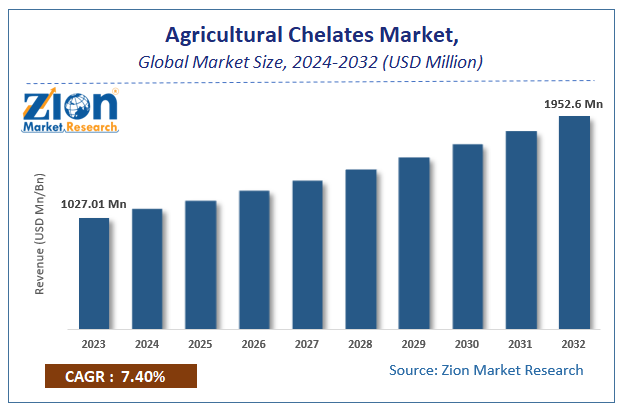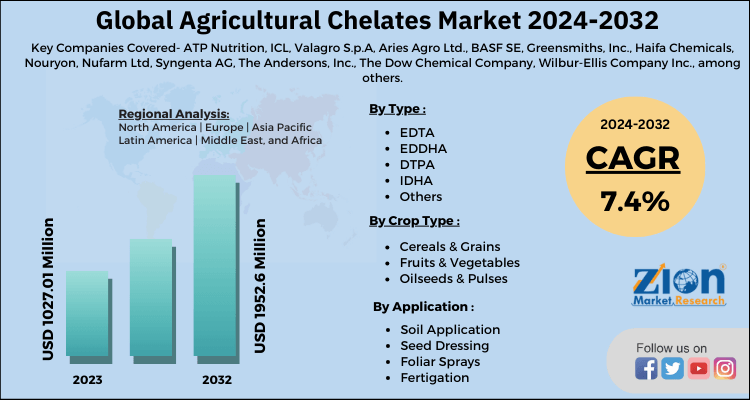Agricultural Chelates Market Size, Share, Trends, Growth 2032

Agricultural Chelates Market By Type (EDTA, EDDHA, DTPA, IDHA, and Others), Crop Type (Cereals & Grains, Fruits & Vegetables, Oilseeds & Pulses, and Others), By Application (Soil Application, Seed Dressing, Foliar Sprays, Fertigation, and Others): Global Industry Perspective, Comprehensive Analysis and Forecast, 2024 - 2032
| Market Size in 2023 | Market Forecast in 2032 | CAGR (in %) | Base Year |
|---|---|---|---|
| USD 1027.01 Million | USD 1952.6 Million | 7.4% | 2023 |
Agricultural Chelates Market Insights
According to a report from Zion Market Research, the global Agricultural Chelates Market was valued at USD 1027.01 Million in 2023 and is projected to hit USD 1952.6 Million by 2032, with a compound annual growth rate (CAGR) of 7.4% during the forecast period 2024-2032.
This report explores market strengths, weakness, opportunities, and threats. It also provides valuable insights into the market's growth drivers, challenges, and the future prospects that may emerge in the Agricultural Chelates industry over the next decade.
Global Agricultural Chelates Market: Overview
The substances used in fertilisers to increase the efficiency of agricultural fertilisers are agricultural chelates. The fertiliser solution applied to these chelates will increase the crop's yield. In agricultural applications, various types of agricultural chelates are used, such as EDTA, DTPA, and EDDHA, etc. These farm chelates can chelate micronutrient fertilisers such as iron, zinc, copper, manganese, and others. The use of these chelates will improve the performance and productivity of micronutrients. In agricultural applications, agricultural chelates are used depending on the type of crop, such as fruits & vegetables, oilseeds & pulses, and others.
Global Agricultural Chelates Market: Growth Factors
The increasing depletion of the soil due to increased demand for high yielding crops would drive the rise in demand for the market for agricultural chelates. Furthermore the rising need for chelated iron micronutrients for agricultural applications will further contribute to an increase in demand for agricultural chelates. Accumulation of non-biodegradable chelates can mainly damage crops and soil, which can impede the growth of the demand for agricultural chelates.
Global Agricultural Chelates Market: Segmentation
The Agricultural Chelates market is fragmented based on type, crop type, and application.
By type, the market is divided into EDTA, EDDHA, DTPA, IDHA, and Others.
On the basis of Crop type, the Agricultural Chelates market includes cereals & grains, fruits & vegetables, oilseeds & pulses, and others. Fruits & vegetables had the largest market share in 2019, and during the projected timeframe, it is still expected to retain its leading position. In the coming years, it is projected that there will be an increase in fruit and vegetable intake.
On the basis of application, the market is segmented into soil application, seed dressing, foliar sprays, fertigation, and others.
Agricultural Chelates Market: Report Scope
| Report Attributes | Report Details |
|---|---|
| Report Name | Agricultural Chelates Market |
| Market Size in 2023 | USD 1027.01 Million |
| Market Forecast in 2032 | USD 1952.6 Million |
| Growth Rate | CAGR of 7.4% |
| Number of Pages | 110 |
| Key Companies Covered | ATP Nutrition, ICL, Valagro S.p.A, Aries Agro Ltd., BASF SE, Greensmiths, Inc., Haifa Chemicals, Nouryon, Nufarm Ltd, Syngenta AG, The Andersons, Inc., The Dow Chemical Company, Wilbur-Ellis Company Inc., among others |
| Segments Covered | By Type, By Crop Type, By Application And By Region |
| Regions Covered | North America, Europe, Asia Pacific (APAC), Latin America, Middle East, and Africa (MEA) |
| Base Year | 2023 |
| Historical Year | 2018 to 2022 |
| Forecast Year | 2024 - 2032 |
| Customization Scope | Avail customized purchase options to meet your exact research needs. Request For Customization |
Global Agricultural Chelates Market: Regional Analysis
Region-wise, the global market is segregated into North America, Europe, Asia Pacific, Latin America, and Middle East & Africa.
In terms of countries, Europe accounted for the largest share of the demand for agricultural chelates in 2019 and is expected to rule the market over the forecast period. Spain and the Netherlands have an expanded area of agriculture, including greenhouse cultivation, due to rising demand from European countries. There are also export demands from these countries for a wide variety of crops, such as pulses, vegetables, cereals, oilseeds and cash crops.
Global Agricultural Chelates Market: Competitive Players
Some main participants of the agricultural chelates market are
- ATP Nutrition
- ICL
- Valagro S.p.A
- Aries Agro Ltd.
- BASF SE
- Greensmiths, Inc
- Haifa Chemicals
- Nouryon
- Nufarm Ltd
- Syngenta AG
- The Andersons, Inc.
- The Dow Chemical Company
- Wilbur-Ellis Company Inc
The agricultural chelates market is segmented as follows:
By Type
- EDTA
- EDDHA
- DTPA
- IDHA
- Others
By Crop Type
- Cereals & Grains
- Fruits & Vegetables
- Oilseeds & Pulses
- Others
By Application
- Soil Application
- Seed Dressing
- Foliar Sprays
- Fertigation
- Others
Agricultural Chelates Market: Regional Segment Analysis
- North America
- The U.S.
- Canada
- Europe
- France
- The UK
- Spain
- Germany
- Italy
- Rest of Europe
- Asia Pacific
- China
- Japan
- India
- South Korea
- Southeast Asia
- Rest of Asia Pacific
- Latin America
- Brazil
- Mexico
- Rest of Latin America
- Middle East & Africa
- GCC
- South Africa
- Rest of Middle East & Africa
Table Of Content
Methodology
FrequentlyAsked Questions
Agricultural chelates are chemical compounds that are employed in agriculture to enhance the availability and assimilation of essential nutrients by plants. Chelates bind metal ions, including iron, zinc, magnesium, copper, and calcium, and prevent them from reacting with other elements in the soil. This could render them unavailable to plants. Chelation is particularly beneficial in soils that are impoverished or alkaline, as it increases the absorption of nutrients that may otherwise be insoluble and inaccessible.
As the global population expands, there is a growing demand for increased agricultural productivity to satisfy the food supply. Crop yields and quality are improved by agricultural chelates, which increase nutrient efficiency.
According to a report from Zion Market Research, the global Agricultural Chelates Market was valued at USD 1027.01 Million in 2023 and is projected to hit USD 1952.6 Million by 2032.
According to a report from Zion Market Research, the global Agricultural Chelates Market a compound annual growth rate (CAGR) of 7.4% during the forecast period 2024-2032.
Region-wise, the global market is segregated into North America, Europe, Asia Pacific, Latin America, and Middle East & Africa.
Some main participants of the Agricultural Chelates market are ATP Nutrition, ICL, Valagro S.p.A, Aries Agro Ltd., BASF SE, Greensmiths, Inc., Haifa Chemicals, Nouryon, Nufarm Ltd, Syngenta AG, The Andersons, Inc., The Dow Chemical Company, Wilbur-Ellis Company Inc., among others.
HappyClients
Zion Market Research
Tel: +1 (302) 444-0166
USA/Canada Toll Free No.+1 (855) 465-4651
3rd Floor,
Mrunal Paradise, Opp Maharaja Hotel,
Pimple Gurav, Pune 411061,
Maharashtra, India
Phone No +91 7768 006 007, +91 7768 006 008
US OFFICE NO +1 (302) 444-0166
US/CAN TOLL FREE +1 (855) 465-4651
Email: sales@zionmarketresearch.com
We have secured system to process your transaction.
Our support available to help you 24 hours a day, five days a week.
Monday - Friday: 9AM - 6PM
Saturday - Sunday: Closed







